Herb garden walls are a fantastic way to add greenery and flavor to your outdoor space. They’re perfect for those who want to maximize their gardening potential without taking up too much room. With a bit of creativity and the right materials, you can transform any wall into a thriving herb haven, making it easy to snip fresh herbs for cooking right from your own backyard.
Seasonal Herbs for Your Garden Wall
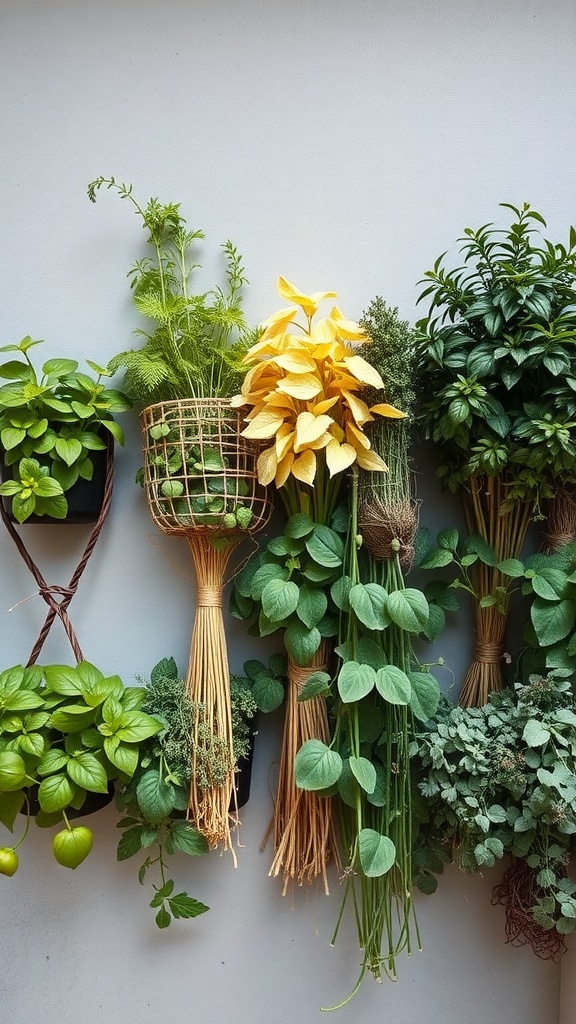
Creating a herb garden wall is a fun and practical way to grow fresh herbs right at home. This image showcases a variety of herbs arranged beautifully against a simple backdrop. The vibrant greens and yellows pop, making it not just functional but also visually appealing.
In the image, you can see herbs like basil, mint, and thyme, all thriving in their vertical space. These herbs are perfect for cooking and can add flavor to many dishes. Having them on a wall makes them easily accessible for quick snips while cooking.
Seasonal herbs can change throughout the year. In spring, you might want to plant fresh basil and cilantro. As summer rolls in, consider adding rosemary and oregano. In the cooler months, thyme and parsley can thrive. This rotation keeps your garden wall lively and productive.
Using wall-mounted planters is a great way to maximize space. You can mix and match different herbs, creating a mini herb paradise. Plus, it’s a great conversation starter for guests who admire your green thumb!
Vertical Herb Garden Design Ideas
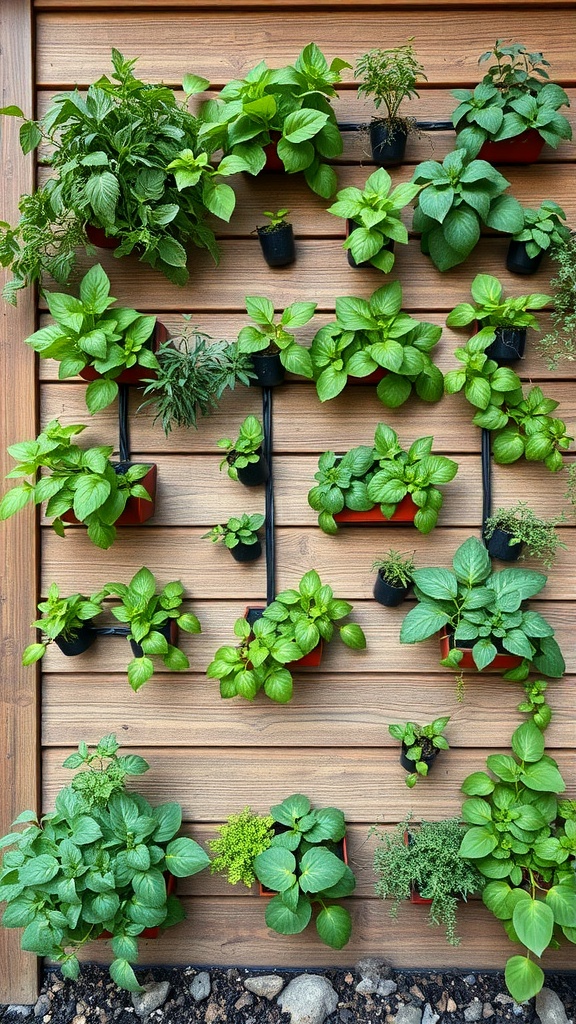
Creating a vertical herb garden is a fantastic way to maximize space while adding greenery to your home. The image showcases a beautifully arranged wall of herbs, featuring a variety of plants in small pots. This design not only looks appealing but also makes it easy to access fresh herbs for cooking.
The wooden backdrop adds warmth and texture, enhancing the overall aesthetic. Each plant is neatly displayed, allowing for easy identification and care. Herbs like basil, mint, and thyme thrive in this setup, providing both beauty and utility.
Vertical gardens are perfect for small spaces, whether it’s a balcony, kitchen, or even a living room wall. They can be customized to fit any style, from rustic to modern. Plus, having fresh herbs on hand can inspire creativity in the kitchen!
Herb Wall Kits for Beginners
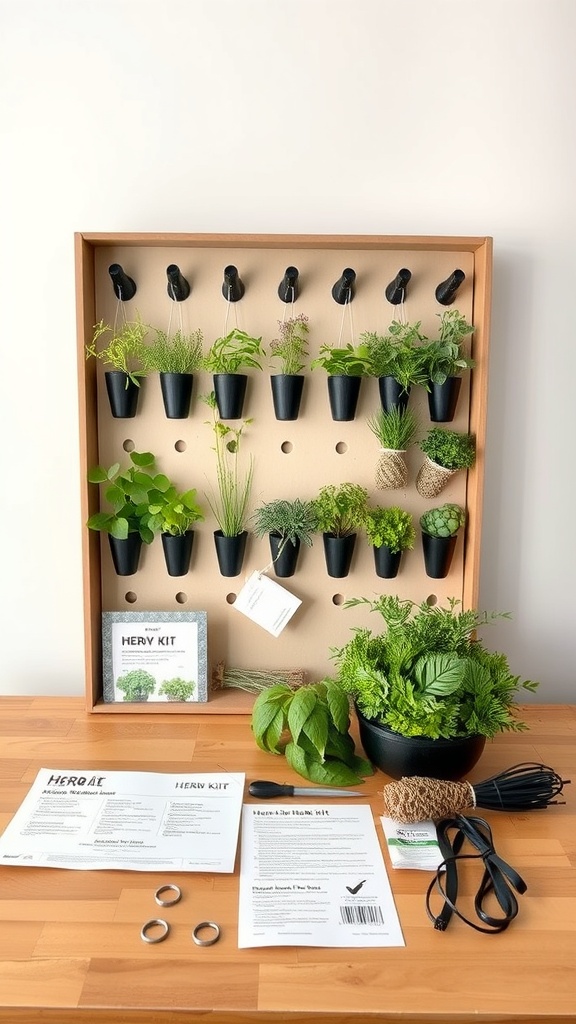
Herb wall kits are a fantastic way to start your own herb garden, especially if you’re new to gardening. The image shows a well-organized herb kit, complete with various herbs in small black pots. This setup is perfect for beginners who want to grow fresh herbs at home.
The kit includes everything you need to get started. You can see the instructions laid out neatly, making it easy to follow along. The herbs displayed, like mint and basil, are popular choices for cooking and add great flavor to dishes.
Having an herb wall not only saves space but also adds a touch of greenery to your kitchen. The design is simple yet effective, allowing you to grow herbs vertically. This is a great option for those with limited space or anyone looking to brighten up their cooking area.
With this kit, you can enjoy the satisfaction of growing your own herbs. It’s a fun project that can lead to delicious meals. Plus, having fresh herbs on hand is a great way to enhance your culinary creations.
Creative Wall Mounting Solutions
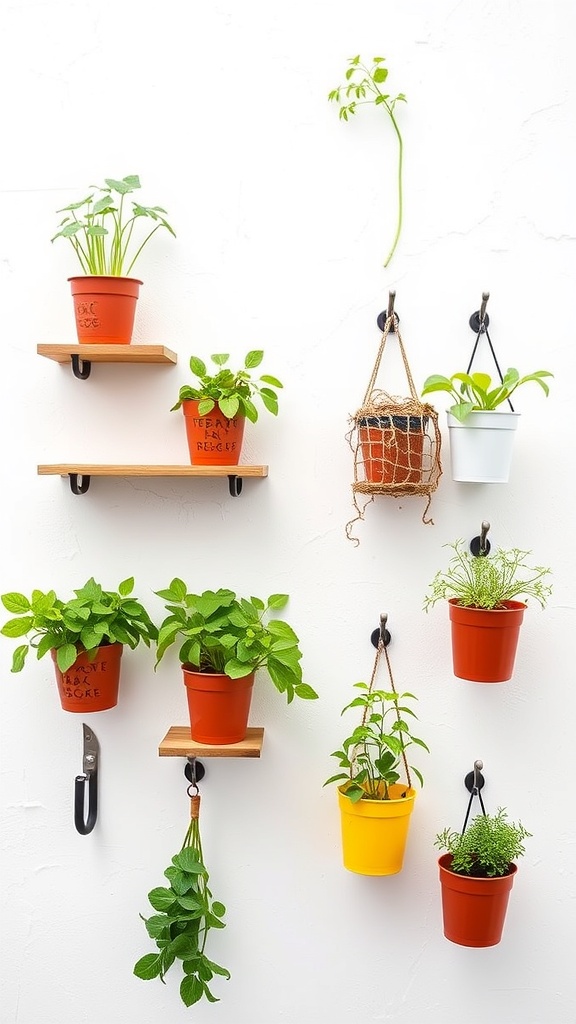
Wall-mounted herb gardens are a fantastic way to bring greenery into your home without taking up much space. The image shows a vibrant display of various herbs in colorful pots, neatly arranged on a white wall. This setup not only looks great but also makes it easy to access fresh herbs for cooking.
The use of shelves and hooks allows for a creative approach to gardening. You can mix and match different pot sizes and colors to create a unique look that fits your style. Plus, having herbs at eye level makes it easier to care for them and adds a lively touch to your kitchen or living area.
Consider using pots with drainage holes to keep your herbs healthy. You can also choose herbs that thrive in your local climate. This way, you can enjoy fresh flavors right from your wall garden. It’s a simple yet effective way to enhance your cooking experience.
Choosing the Right Herbs for Your Wall
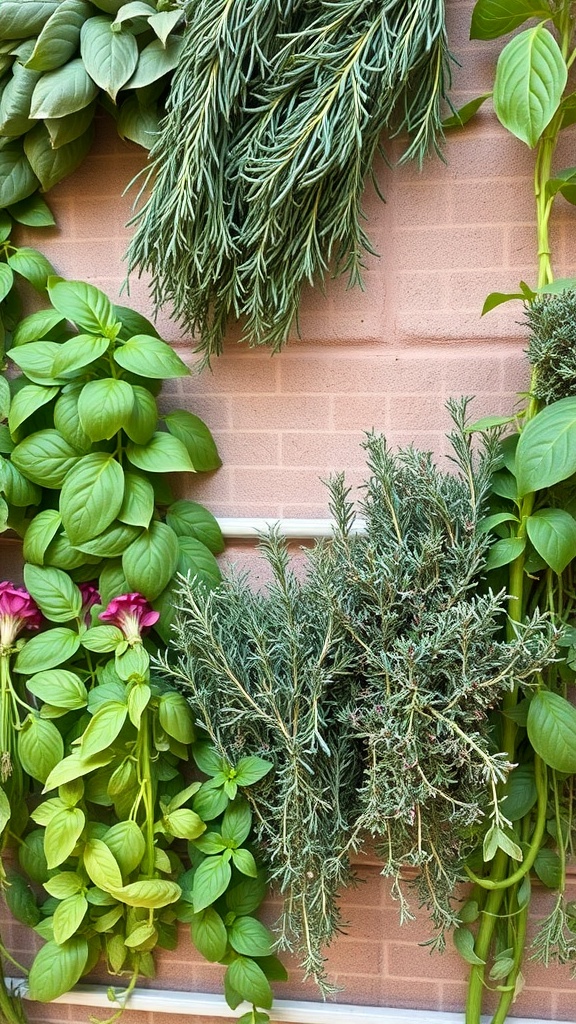
Creating a herb garden wall is a fun way to bring fresh flavors to your kitchen. The image shows a variety of herbs, each with its own unique look and scent. Choosing the right herbs can make your wall not just beautiful, but also practical.
Start with popular choices like basil and rosemary. Basil is great for sauces and salads, while rosemary adds a lovely aroma to roasted dishes. Both thrive in vertical gardens and can be easily snipped for cooking.
Don’t forget about thyme and mint. Thyme is hardy and can handle different conditions, making it a solid choice. Mint, on the other hand, can spread quickly, so keep it in check. It’s perfect for teas and desserts.
Consider the sunlight your wall gets. Some herbs, like parsley and cilantro, prefer partial shade, while others, like oregano, love the sun. Make sure to group them according to their needs for the best results.
Lastly, think about how you’ll use these herbs. If you love cooking, choose those that complement your favorite dishes. A well-planned herb wall can be a delightful addition to your home.
DIY Herb Wall Planters
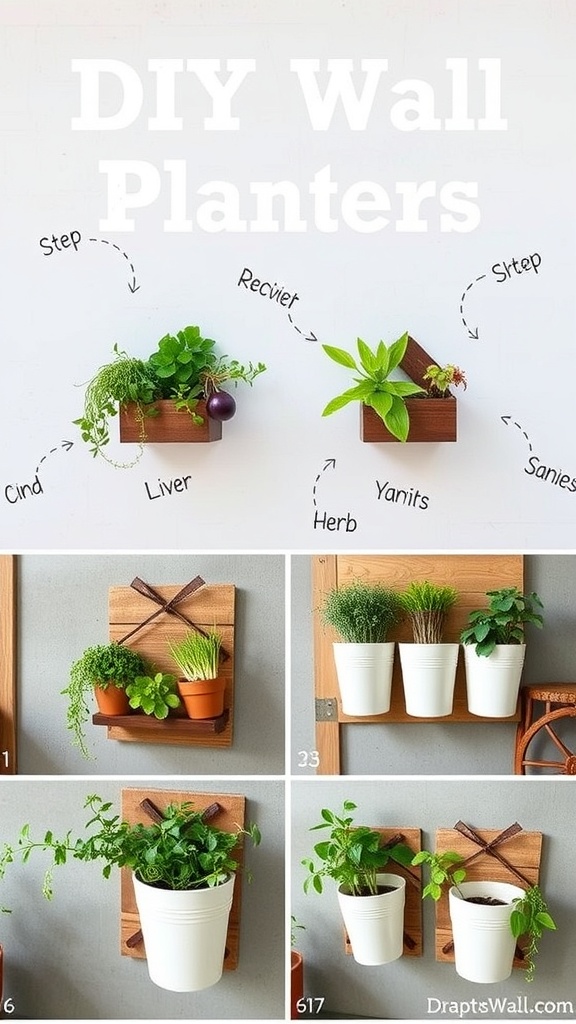
Creating your own herb wall planters is a fun and rewarding project. The image shows a variety of DIY planters that can brighten up your space while providing fresh herbs at your fingertips. These planters come in different styles, from wooden boxes to simple pots, making it easy to find a design that fits your home.
Each planter is designed to hold herbs like basil, mint, and parsley. You can easily customize the arrangement to suit your taste. The wall-mounted feature saves space and adds a unique touch to your kitchen or garden area. Plus, having fresh herbs on hand can elevate your cooking.
To get started, gather your materials. You’ll need some planters, potting soil, and your favorite herb seeds or seedlings. Mount the planters on a wall that gets plenty of sunlight. Fill each planter with soil, plant your herbs, and water them regularly. In no time, you’ll have a thriving herb garden right on your wall!
Maintaining Your Herb Garden Wall
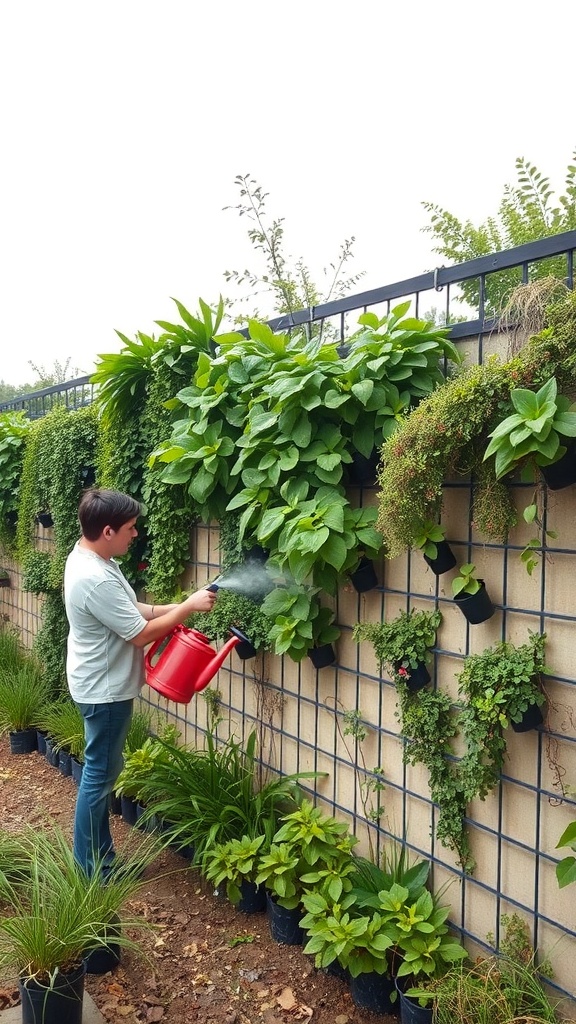
Keeping your herb garden wall thriving is a fun and rewarding task. In the image, you can see someone watering a lush wall of herbs, which shows how important hydration is for healthy growth. Regular watering helps the plants flourish and keeps them vibrant.
It’s essential to check the moisture levels in your herb wall. Herbs like basil, mint, and rosemary can be thirsty, especially in warmer weather. Make sure to water them consistently, but avoid overwatering, as this can lead to root rot.
Pruning is another key part of maintenance. Snipping off dead leaves and encouraging new growth keeps your herbs looking fresh. This also helps prevent pests from taking hold. A well-maintained herb garden wall not only looks good but also produces better yields.
Fertilizing your herbs can boost their growth. Use organic fertilizers that are suitable for herbs. This will ensure they get the nutrients they need without harmful chemicals.
Lastly, keep an eye out for pests. Regularly inspect your plants for any signs of trouble. If you spot any pests, act quickly to remove them. A healthy herb garden wall can be a beautiful and functional addition to your space.
Benefits of Herb Garden Walls
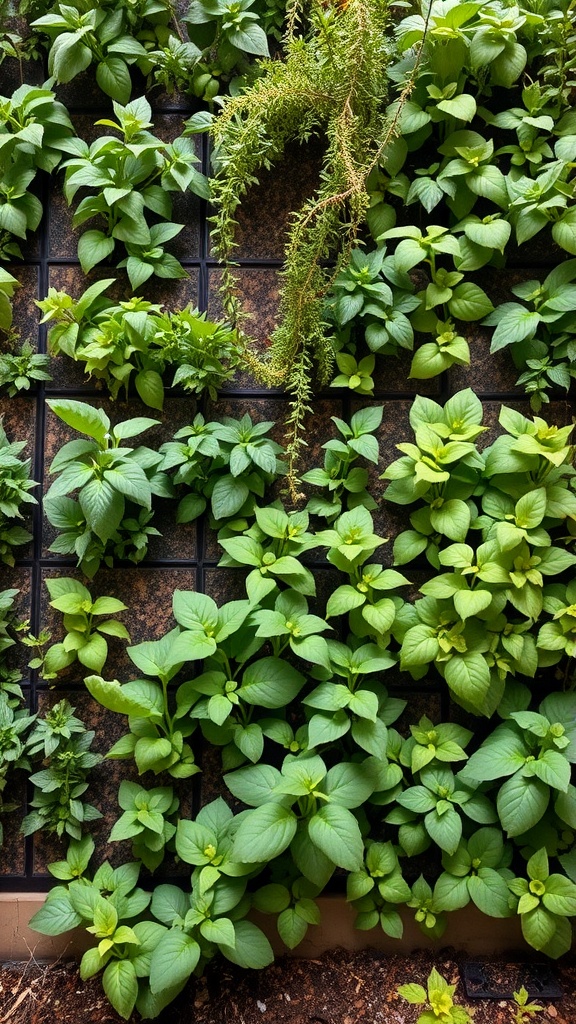
Herb garden walls are a fantastic way to bring greenery into your space. They not only look great but also offer practical benefits. Imagine a wall filled with fresh herbs, ready for cooking or garnishing your meals.
One major advantage is space-saving. If you have limited outdoor space, vertical gardening lets you grow a variety of herbs without taking up much room. You can easily fit a herb wall in a small backyard, balcony, or even indoors.
Another perk is accessibility. Having your herbs at eye level makes it easy to snip off what you need while cooking. No more bending down or digging through pots. Just reach out and grab your favorite basil or mint!
Herb garden walls also contribute to better air quality. Plants naturally filter the air, making your environment healthier. Plus, they add a touch of nature that can boost your mood.
Finally, growing your own herbs can save you money. Instead of buying fresh herbs at the store, you can harvest them right from your wall. This not only cuts costs but also ensures you have fresh ingredients on hand whenever you need them.
Using Recycled Materials for Herb Walls
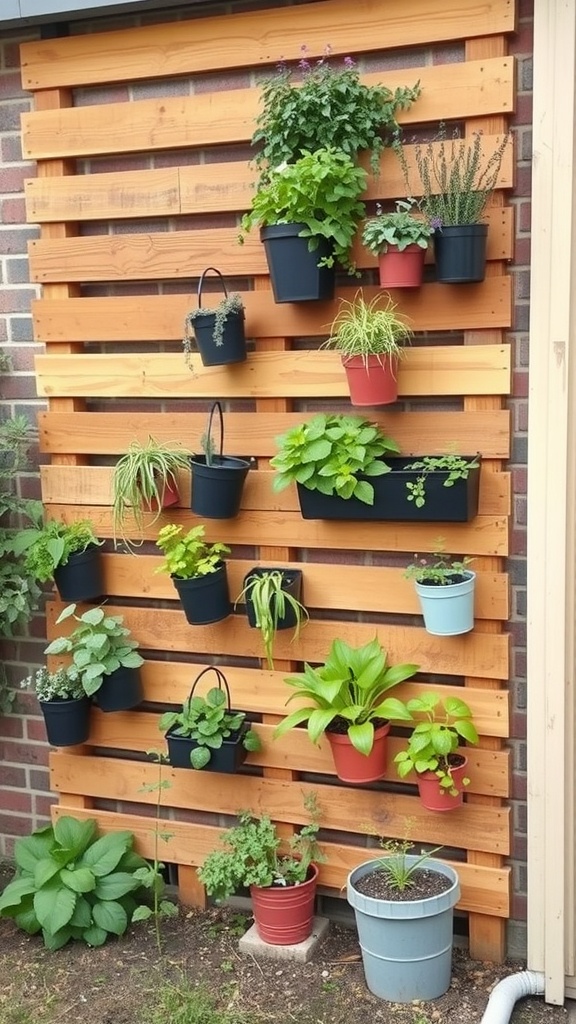
Creating a herb wall using recycled materials is a fun and eco-friendly project. The image shows a wooden structure with various herbs growing in pots attached to it. This setup not only saves space but also adds a unique touch to your garden.
Using reclaimed wood for the frame is a great way to reduce waste. It gives a rustic look and is sturdy enough to hold the pots. You can find old pallets or leftover wood from other projects to create your herb wall.
The pots can also be recycled. Old containers, like tin cans or plastic bottles, can be transformed into planters with a little creativity. Just make sure to add drainage holes so your herbs don’t drown!
This herb wall is perfect for small spaces. It allows you to grow a variety of herbs like basil, mint, and thyme right at home. Plus, having fresh herbs on hand makes cooking even more enjoyable.
So, gather your materials and start building your own herb wall. It’s a simple way to bring greenery into your life while being kind to the planet!
Herb Garden Wall in Small Spaces
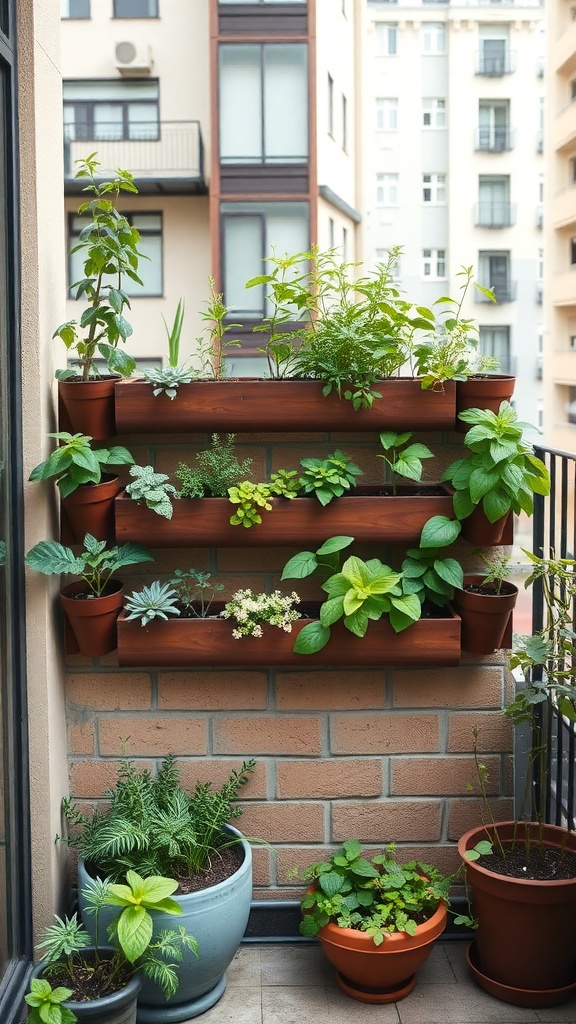
Creating a herb garden wall is a fantastic way to make the most of limited space. This setup allows you to grow a variety of herbs right on your balcony or patio. The image shows a beautifully arranged wall planter, filled with lush greenery.
The vertical design is perfect for small areas. It maximizes space while providing easy access to fresh herbs. You can see pots filled with different plants, from mint to basil, all thriving together. This not only adds beauty but also brings a delightful aroma to your home.
Using a wall for your herb garden means you can enjoy gardening without needing a large yard. It’s a simple solution that can fit into any urban lifestyle. Plus, having fresh herbs on hand makes cooking more enjoyable and flavorful.
Consider adding a few pots at the base for larger plants or flowers. This can create a layered look that enhances the overall design. With a little creativity, your herb garden wall can become a stunning focal point in your outdoor space.
Herb Wall Irrigation Solutions
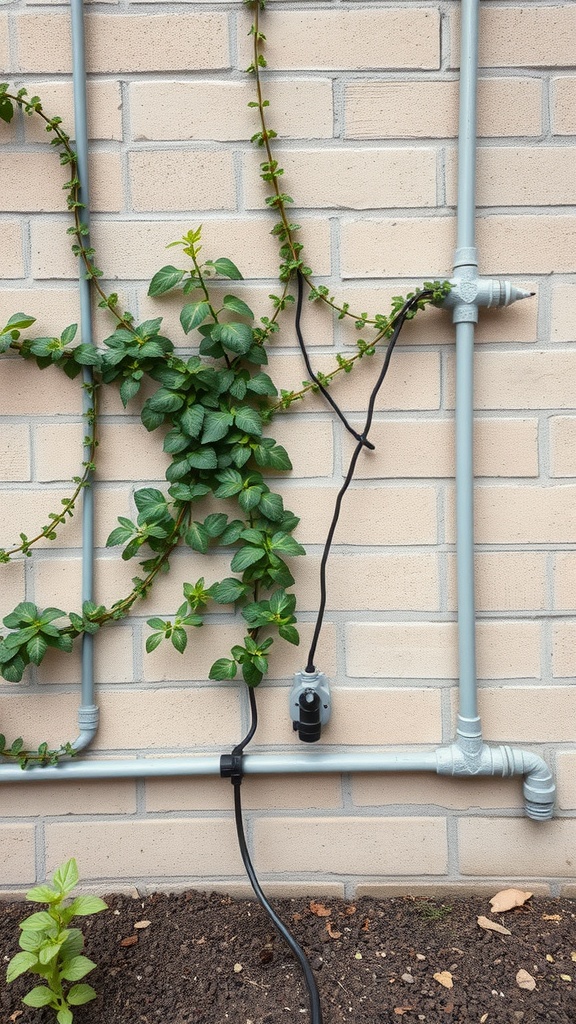
Creating a herb wall is a fantastic way to grow your favorite plants in a limited space. The image shows a clever irrigation setup that keeps the plants hydrated while they climb the wall. The pipes are neatly arranged, providing a structured look that complements the greenery.
Using a wall for herbs not only saves space but also adds a unique aesthetic to your garden. The irrigation system ensures that each plant gets the right amount of water without the hassle of manual watering. This setup is especially useful for busy gardeners who want to maintain a thriving herb garden.
Incorporating an irrigation solution like this can make a big difference. It allows you to focus on enjoying your herbs rather than worrying about their care. Plus, it can be a fun DIY project to set up!
Herbs That Thrive in Wall Gardens
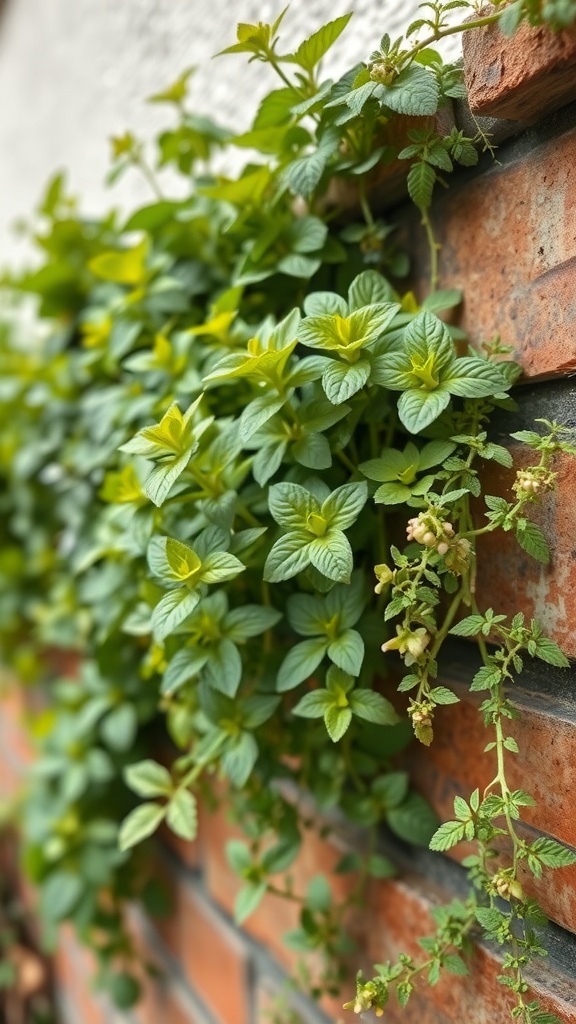
Wall gardens are a fantastic way to grow herbs, especially if space is limited. The image showcases vibrant green herbs climbing a brick wall, creating a lush and inviting atmosphere. This setup not only saves space but also adds a unique aesthetic to any garden.
Mint is a popular choice for wall gardens. Its vigorous growth and refreshing scent make it a favorite among gardeners. It can easily spread, so keeping it contained in a wall garden is ideal.
Another great option is thyme. This hardy herb thrives in various conditions and can tolerate some neglect. Its tiny leaves and delicate flowers add charm to any vertical garden.
Oregano is also a wonderful herb for wall gardens. It loves the sun and can flourish in well-drained soil. Plus, it’s perfect for culinary uses, making it a practical choice.
Lastly, consider basil. This herb loves warmth and can grow beautifully in a wall garden. Its fragrant leaves are perfect for adding flavor to dishes.
Herb Wall for Indoor Spaces
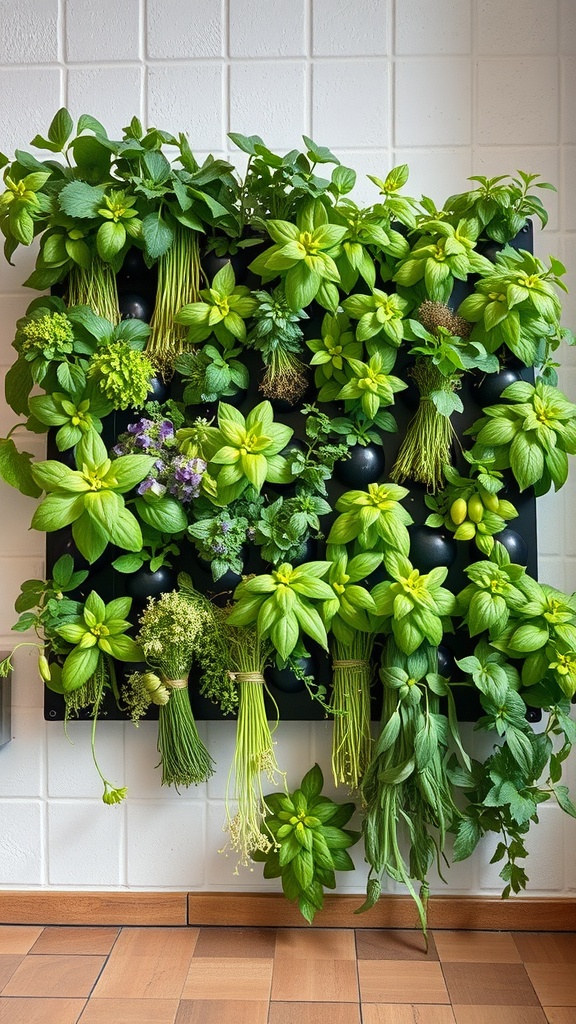
Creating a herb wall in your indoor space can be a fun and rewarding project. This image shows a vibrant display of various herbs, all thriving together. The lush greenery adds a refreshing touch to any room.
Herb walls are not just visually appealing; they also provide fresh ingredients for cooking. Imagine snipping off some basil or mint right from your wall for your next meal. It’s a great way to incorporate fresh flavors into your dishes.
Setting up an herb wall is simple. You can use wall-mounted planters or vertical garden systems. Choose herbs that you love and that grow well indoors, like basil, parsley, and cilantro. Make sure they get enough light, either from a window or grow lights.
Maintaining your herb wall is easy. Regular watering and occasional pruning will keep your herbs healthy and productive. Plus, caring for plants can be a relaxing hobby.
Integrating Herb Walls into Landscape Design
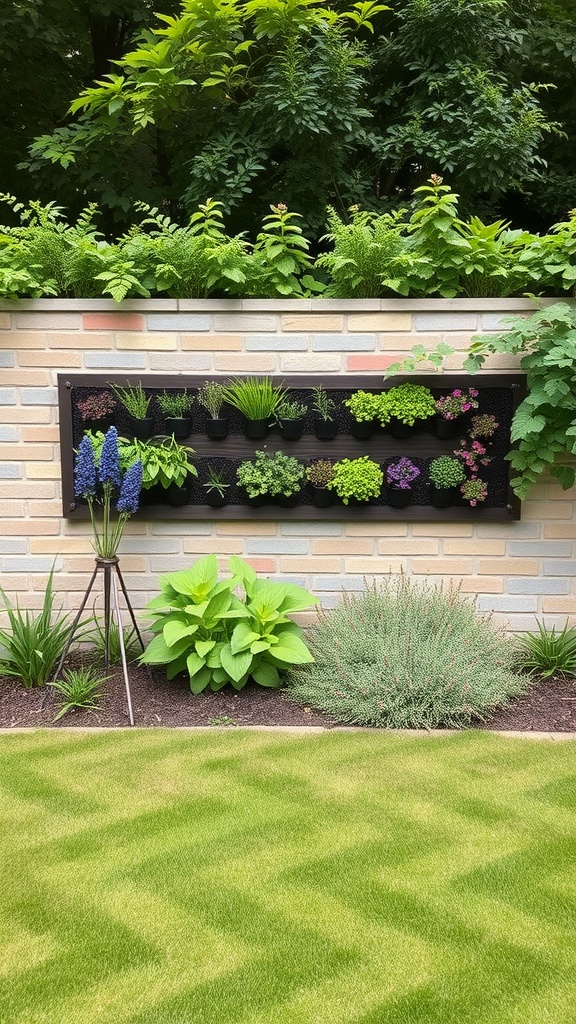
Herb walls are a fantastic way to bring greenery into your outdoor space. They not only look great but also serve a practical purpose. Imagine having fresh herbs right at your fingertips for cooking or garnishing dishes.
The image shows a well-organized herb wall, featuring various herbs in neat rows. This setup makes it easy to access and maintain the plants. The vibrant colors of the herbs contrast beautifully with the brick wall, creating a lively focal point in the garden.
Incorporating herb walls into your landscape design can enhance the overall aesthetic. They can be placed against fences or walls, making use of vertical space. This is especially useful for smaller gardens where ground space is limited.
Besides being visually appealing, herb walls can attract beneficial insects, adding to the ecosystem of your garden. They can also provide a pleasant aroma, making your outdoor area feel more inviting.
When planning your herb wall, consider the types of herbs you enjoy cooking with. Popular choices include basil, rosemary, and thyme. These herbs not only thrive in vertical gardens but also add flavor to your meals.
Herb Wall Aesthetics and Decor
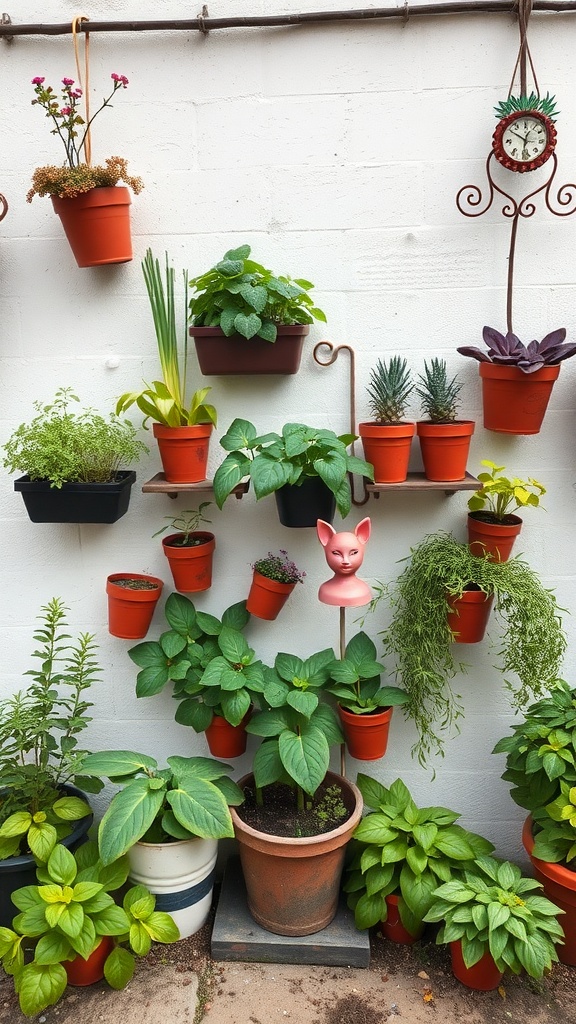
Creating a herb wall is a fun and stylish way to bring greenery into your space. The image shows a vibrant display of various herbs and plants arranged on a wall. Each pot adds a pop of color and life, making the area feel fresh and inviting.
The use of terracotta pots against a white wall creates a striking contrast. This combination not only highlights the plants but also adds a rustic charm to the decor. The different shapes and sizes of the pots contribute to an interesting visual appeal.
Incorporating a few decorative elements, like the whimsical pink head and the clock, adds personality to the herb wall. These small touches make the space feel unique and personal, inviting you to spend more time enjoying your garden.
Herb walls are not just about aesthetics; they also serve a practical purpose. Fresh herbs can enhance your cooking and provide a delightful fragrance. Imagine snipping fresh basil or mint right from your wall whenever you need it!
Edible Flowers for Herb Wall Gardens
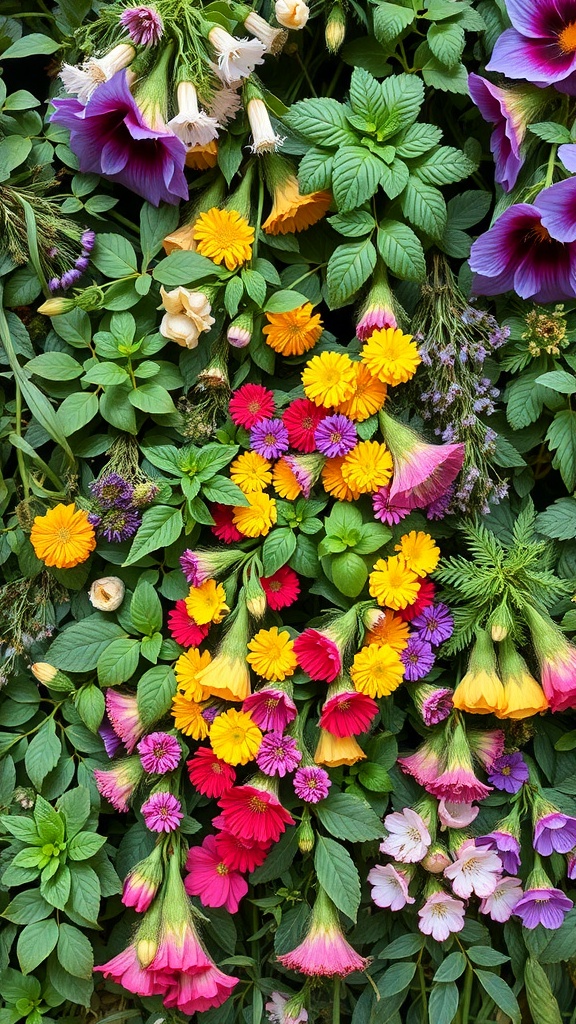
Creating an herb wall garden is a fun way to add color and flavor to your space. Edible flowers can enhance this experience, making your garden not just practical but also visually stunning. The image shows a vibrant mix of flowers and greens, showcasing how beautiful an herb wall can be.
Flowers like nasturtiums, pansies, and calendulas are great choices. They not only look pretty but also add unique flavors to dishes. For instance, nasturtiums have a peppery taste that can spice up salads. Pansies, with their mild flavor, can be used to decorate desserts or drinks.
When planning your herb wall, think about the colors and textures of the flowers. The image highlights a variety of blooms, from bright yellows to deep purples, creating a lively display. Mixing different types of flowers can make your garden more appealing and inviting.
Don’t forget to consider the growing conditions for each flower. Some prefer full sun, while others thrive in partial shade. This will help ensure that your herb wall flourishes and remains healthy.
Incorporating edible flowers into your herb wall garden is a delightful way to enjoy nature’s beauty while also enhancing your culinary creations. So, grab some seeds and start planting!
Herb Wall Lighting Solutions
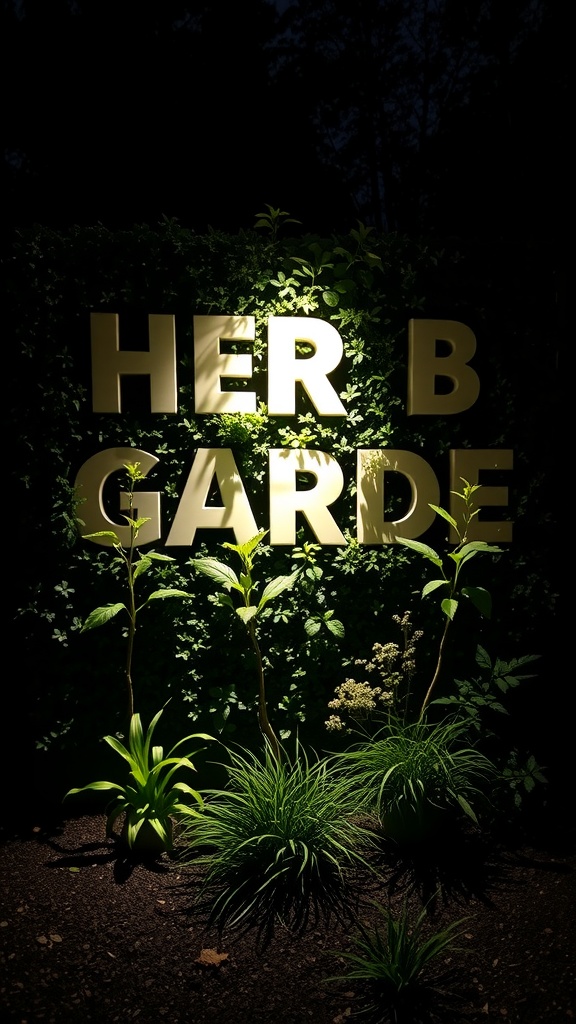
Lighting plays a key role in showcasing your herb garden wall. The image captures a beautifully illuminated sign that reads ‘HERB GARDEN,’ surrounded by lush greenery. This setup not only highlights the plants but also creates a warm and inviting atmosphere.
Using soft, focused lighting can enhance the visual appeal of your herbs. Consider installing LED spotlights that gently illuminate the plants without overwhelming them. This way, you can enjoy the beauty of your garden even after the sun goes down.
Incorporating lights into your herb wall can also serve practical purposes. For instance, it can help you easily identify and access your herbs during evening cooking sessions. Plus, the right lighting can deter pests, as many are less active in well-lit areas.
Overall, a well-lit herb garden wall adds charm and functionality to your outdoor space. It invites you to enjoy your garden at any hour, making it a delightful addition to your home.
Herb Wall Community Garden Projects
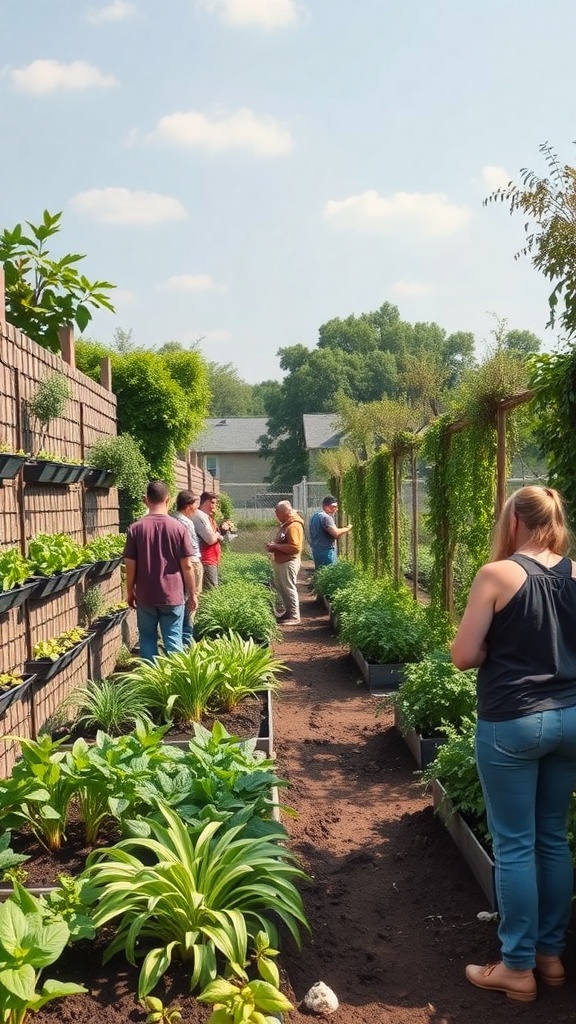
Community gardens are a fantastic way to bring people together, and herb wall projects are a unique twist on this idea. In the image, you can see a vibrant herb garden where people are engaged in various activities. The vertical walls are lined with lush greenery, showcasing a variety of herbs that are easy to grow and maintain.
These herb walls not only save space but also create a stunning visual appeal. They allow community members to cultivate their own herbs while fostering a sense of teamwork. You can spot individuals chatting and tending to the plants, highlighting the social aspect of gardening.
Herb walls can be a great educational tool too. They provide an opportunity for workshops on gardening techniques, cooking with fresh herbs, and even sustainability practices. This kind of project encourages everyone to get involved, whether they are seasoned gardeners or just starting out.
Overall, herb wall community gardens are a wonderful way to promote healthy living, community bonding, and environmental awareness. They show how gardening can be both practical and beautiful, making it a rewarding experience for all involved.
Herb Wall Workshops and Classes
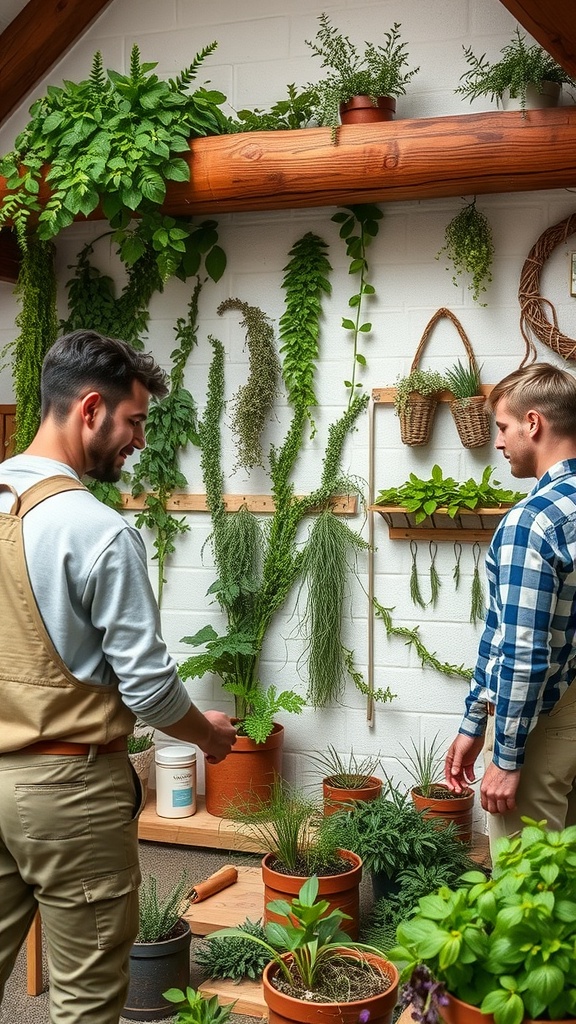
Herb wall workshops and classes are a fantastic way to learn about growing your own herbs. In these sessions, participants can explore various techniques for creating vertical gardens. The image shows a lovely setup with herbs displayed on a wall, making it easy to access and maintain them.
During the workshops, you’ll get hands-on experience planting herbs like basil, mint, and rosemary. The instructors guide you through the process, sharing tips on watering and sunlight needs. Plus, you’ll meet fellow gardening enthusiasts who share your passion.
Classes often include discussions on the benefits of having fresh herbs at home. You can use them in cooking, teas, or even for natural remedies. The vibrant green plants in the image highlight how beautiful and practical an herb wall can be.
Whether you’re a beginner or have some gardening experience, these workshops are welcoming and informative. You’ll leave with your own herb wall creation and the knowledge to keep it thriving.
Herb Wall Success Stories
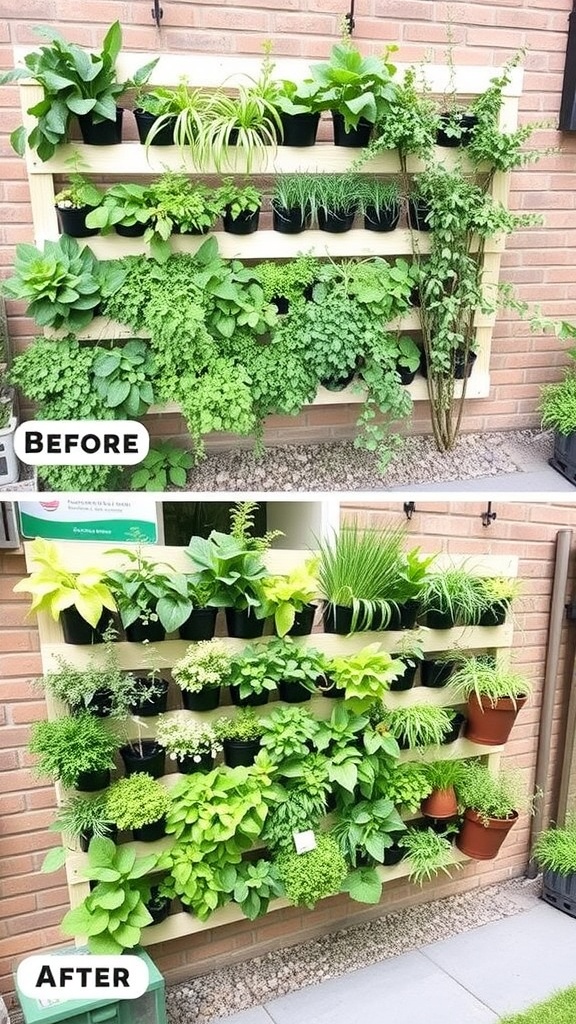
Transforming a plain wall into a vibrant herb garden is a fantastic way to add life to your space. The image shows a remarkable before-and-after of a herb wall. Initially, the wall was quite bare, featuring only a few plants and some signage. After the makeover, it bursts with greenery and a variety of herbs, creating a stunning visual impact.
This transformation not only beautifies the area but also serves a practical purpose. Herbs like basil, mint, and thyme can be easily accessed for cooking. It’s a great reminder that even small spaces can be turned into productive gardens.
Community gardens and local initiatives often inspire these projects. They show how creativity can turn ordinary walls into extraordinary herb walls. This success story encourages others to think outside the box and consider their own herb garden walls.
Companion Planting with Herb Walls
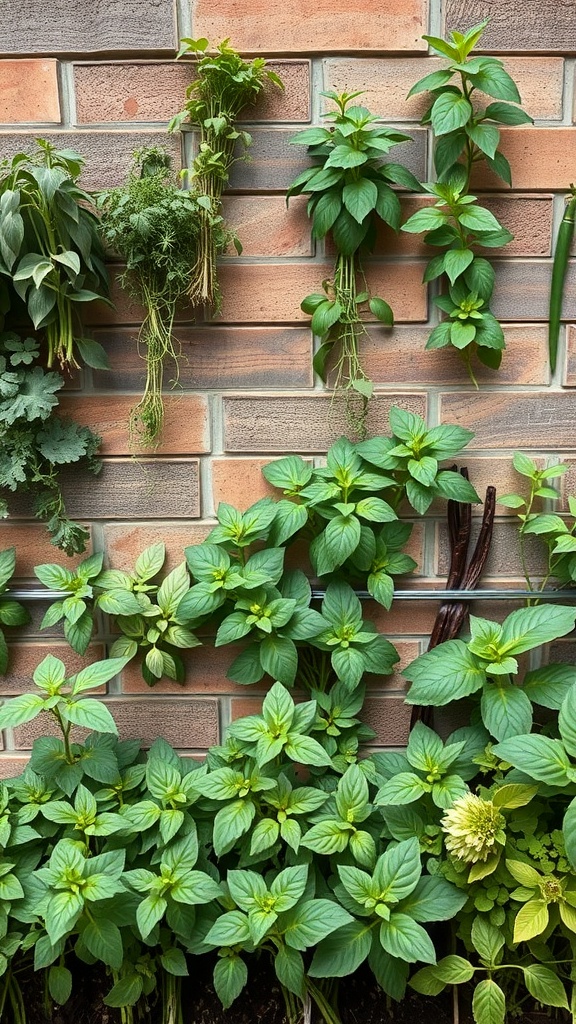
Herb walls are a fantastic way to grow your favorite herbs while saving space. In the image, you can see a vibrant display of various herbs climbing a wall, creating a lush green backdrop. This setup not only looks great but also serves a practical purpose.
Companion planting is all about pairing plants that benefit each other. For instance, basil and tomatoes are a classic duo. When you grow them together, basil can enhance the flavor of tomatoes and help repel pests. With a herb wall, you can easily mix and match different herbs to create the perfect companions.
Using a vertical garden for herbs allows you to maximize your gardening area. You can plant herbs like cilantro, mint, and parsley in a small space while keeping them accessible for cooking. Plus, having fresh herbs on hand makes meal prep more enjoyable.
To get started, choose herbs that grow well together. Consider their sunlight and water needs. Regularly harvesting your herbs will encourage growth and keep your wall looking full and healthy. Enjoy the benefits of companion planting and the beauty of a herb wall in your garden!
Herb Wall Maintenance Tools
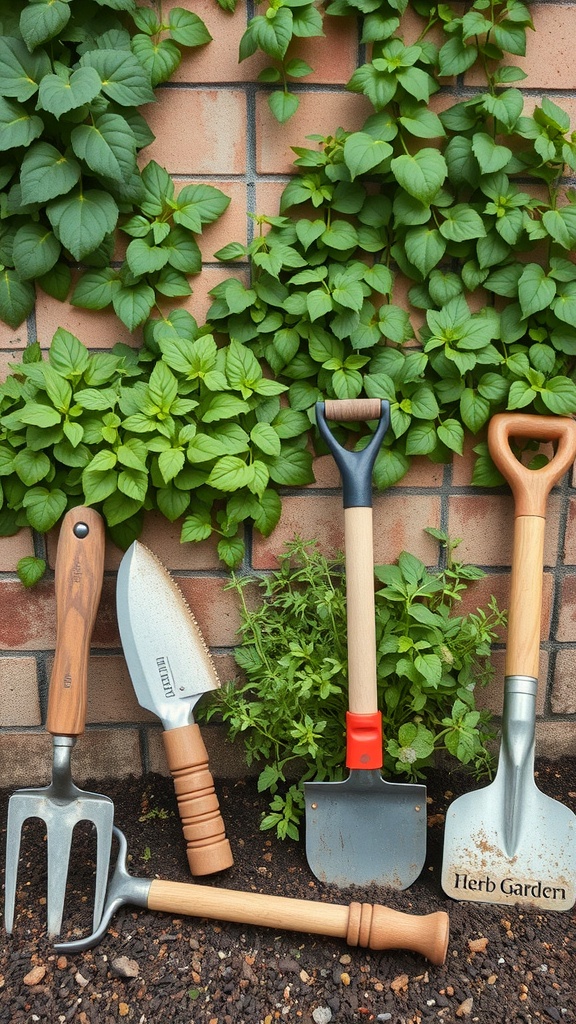
Maintaining a herb wall is a rewarding task, and having the right tools makes it even easier. In the image, you can see a selection of essential gardening tools laid out against a backdrop of lush green herbs. Each tool serves a specific purpose, helping you keep your herb garden thriving.
The fork is perfect for aerating the soil, ensuring that your herbs get the nutrients they need. The trowel is great for digging and planting, making it easier to add new herbs to your wall. The hand cultivator is handy for breaking up soil and removing weeds, keeping your garden tidy.
Don’t forget the weeder, which helps you tackle those pesky weeds that can compete with your herbs for resources. Lastly, the spade is ideal for larger digging tasks and moving soil around. With these tools in hand, maintaining your herb wall becomes a breeze!
Herb Wall Sustainability Practices
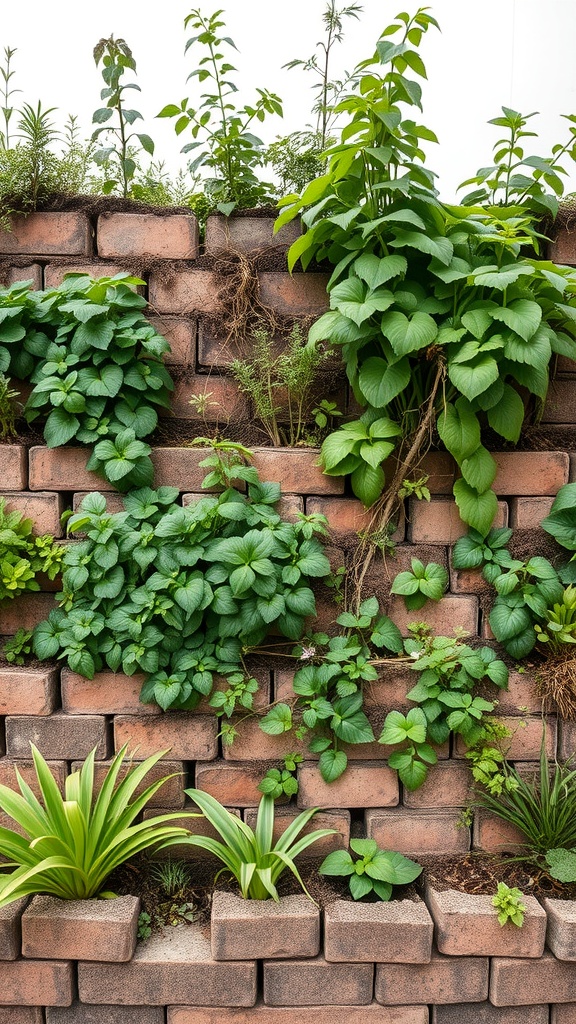
Creating a herb wall is a fantastic way to grow your own herbs while being eco-friendly. The image shows a vertical garden made from bricks, filled with various herbs and plants. This setup not only saves space but also adds a touch of greenery to any area.
Using a wall for your herb garden helps with water conservation. The vertical design allows rainwater to trickle down, nourishing the plants below. This means less frequent watering, which is great for the environment.
Choosing native plants for your herb wall can enhance sustainability. Native herbs often require less maintenance and are more resilient to local pests and diseases. This reduces the need for chemical treatments, making your garden healthier.
Another practice is composting. By using kitchen scraps to create compost, you can enrich the soil in your herb wall. This not only benefits the plants but also reduces waste.
Finally, consider using organic fertilizers. They are better for the environment and help keep your herbs safe from harmful chemicals. An herb wall can be both beautiful and sustainable with these practices in mind.
Herb Wall as a Culinary Resource
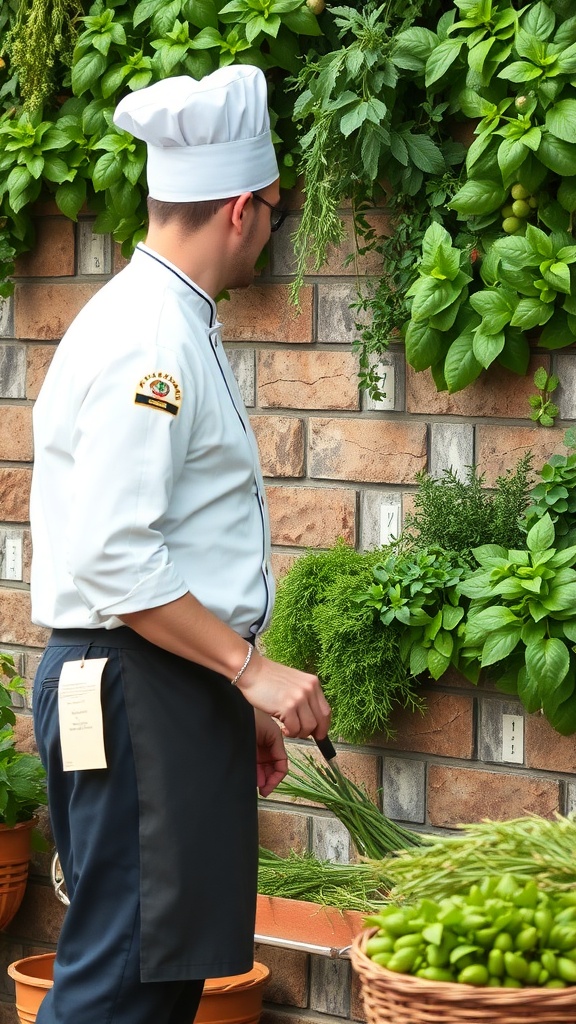
Imagine stepping into a kitchen where fresh herbs are just a reach away. An herb wall transforms cooking into a delightful experience. This setup not only looks great but also brings a burst of flavor to your dishes.
The image shows a chef standing in front of a vibrant herb wall. The lush greenery includes various herbs, ready to be snipped and added to meals. This wall acts as a living pantry, providing easy access to ingredients that enhance any recipe.
Using fresh herbs can elevate simple dishes. For example, a sprinkle of basil can brighten a tomato sauce, while a handful of cilantro can add a refreshing twist to tacos. The chef in the image is likely preparing to use these herbs, showcasing how they can be a vital part of meal prep.
Creating your own herb wall is simple. Start with pots of your favorite herbs like rosemary, thyme, and mint. Arrange them on a wall or shelf where they can get plenty of sunlight. Regularly trimming the herbs encourages growth and keeps them fresh for cooking.
